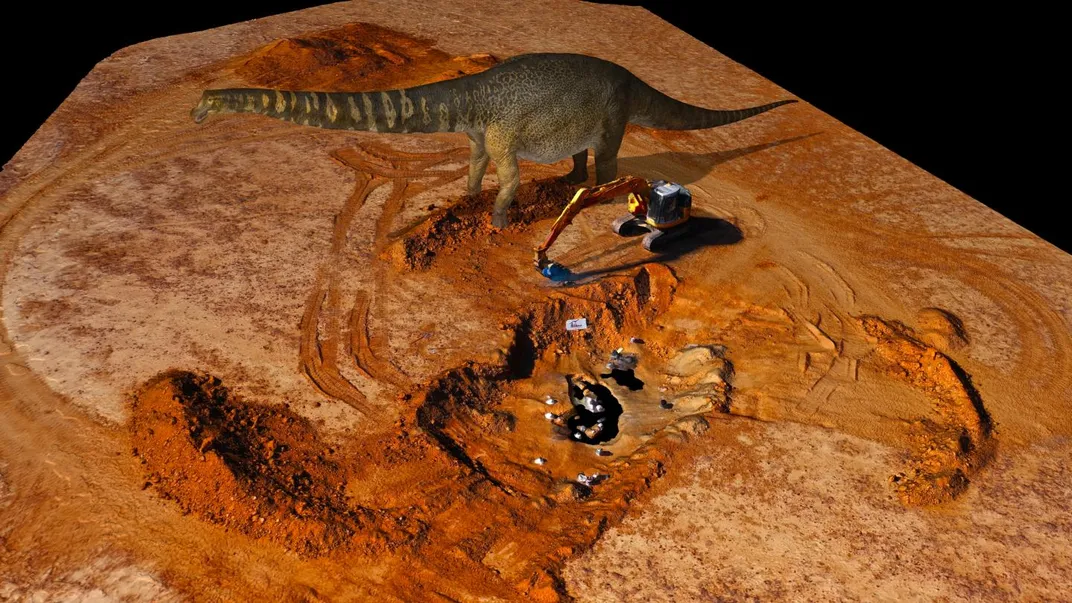Two Farmers Found the Largest Dinosaur Ever Unearthed in Australia
The long-necked herbivore’s length measured the span of a basketball court, stood at two stories, and weighed an estimated 70 tons
/https://tf-cmsv2-smithsonianmag-media.s3.amazonaws.com/filer/5d/58/5d58645e-7446-4b8e-a853-e6fba00205af/267060_web.jpg)
In 2006, Robyn and Stuart Mackenzie spotted what appeared to be massive black rocks while riding motorbikes on their sheep and cattle farm in Australia, reports Jennifer Jet for the New York Times. But upon closer inspection, they realized the rocks were bones.
Now, after over a decade of excavation and analyzing the enormous bones, researchers at the Queensland Museum and Eromanga Natural History Museum classified the fossil remains as a new species, Australotitan cooperensis, or "the southern titan," belonging to the genus titanosaur. The dinosaur is the largest ever found in Australia and one of the largest in the world. The study was published this week in PeerJ - the Journal of Life and Environmental Sciences.
Nicknamed Cooper, the titanosaur's bones were unearthed near Cooper Creek at the Eromanga Basin in southwest Queensland. Researchers found its shoulder blades, pelvic bones, and limbs mostly intact, reports Donna Lu for the Guardian. Titanosaurs are long-necked herbaceous sauropod dinosaurs that walked the Earth from the late Jurassic Epoch to the end of the Cretaceous period. They were some of the largest dinosaurs that ever existed.
While other titanosaur species were found in Australia before, Cooper is significantly larger. It is estimated that Cooper weighed 70 tons, stood at two stories tall, and measured 82 to 98 feet in length—or about the size of a basketball court, the New York Times reports.
Cooper's appearance is similar to other familiar long-necked sauropods, Brachiosaurus and Apatosaurus. Before Cooper, titanosaurs were previously only discovered in South America, reports Australia's ABC News.
It took over a decade to identify Cooper because of the bones' remote location, fragile condition, and massive size that at times require a forklift to move, the Guardian reports.
"It's taken this long because it's such a painstaking piece of work, you've got to take the bones out of the ground, you've got to prepare the fossils, and then you've got to study them and compare them against all other species of dinosaurs worldwide," vertebrae paleontologist and co-author Scott Hocknull tells ABC News.

Paleontologists confirmed that Cooper was a new species of giant sauropod by comparing 3-D scans of its bones with its closest relatives. The scans allowed researchers to safely examine the fragile, extremely heavy bones without damaging them. Researchers identified Cooper's age through geological dating of the sediments surrounding the fossils, the Guardian reports. While further examining Cooper's bones, the team also found crush marks, suggesting that Cooper may have died from being trampled by other sauropods.
Australia has become an epicenter for paleontology with numerous discoveries of new dinosaur species and megafauna made in the last two decades, explained Jim Thompson, CEO of the Queensland Museum Network, in a statement. Farmers can be a big asset to paleontology by looking for peculiar "rocks" on their land.
"Dinosaurs find you," study co-author Scott Hocknull, a paleontologist at the Queensland Museum in Brisbane, tells the Times.
That's certainly true for the Mackenzie family. Their son Sandy, who was 14 years old at the time, first found dinosaur bones on their property in 2004. Robyn Mackenzie is now a field paleontologist and co-authored the paper about Australotitan cooperensis. Her husband Stuart is also named as a co-author on the study. Together with the Eromanga community—a small town of 60 people—the family established the Eromanga Natural History Museum, which opened in 2016. Cooper's bones will remain at the museum, where attendance has tripled in recent years. The Mackenzies say they are currently unearthing new bones on their land that may also belong to a new species of dinosaur.
“This is sort of our first hat in the ring, getting into the big leagues of big titanosaur dinosaurs worldwide,” Hocknull tells the Times. “We’re pretty excited about it because it’s just the start of what we think might be a new wave of discoveries of very large dinosaur species in Australia.”
/https://tf-cmsv2-smithsonianmag-media.s3.amazonaws.com/accounts/headshot/gamillo007710829-005_0.png)
/https://tf-cmsv2-smithsonianmag-media.s3.amazonaws.com/accounts/headshot/gamillo007710829-005_0.png)